Legislative Yuan
The Legislative Yuan is the unicameral legislature of the Republic of China (Taiwan). Located in Taipei, the Legislative Yuan is composed of 113 legislators, which are directly elected by people of the Free Area through a parallel voting system for 4-year terms. Like parliaments or congresses of other countries, the Legislative Yuan is responsible for the passage of legislation, which is then sent to the President for signing. For these similarities, it is also common for people to refer to the Legislative Yuan as "the parliament" (國會; Guóhuì; Kok-hōe).
Legislative Yuan 立法院 | |
|---|---|
| 10th Legislative Yuan | |
 | |
| Type | |
| Type | |
| History | |
| Founded | 5 December 1928 (pre-constitutionalization) 18 May 1948 (by 1947 Constitution)[1][2] 24 February 1950 (in Taipei) 7 June 2005 (unicameral parliament) |
| Leadership | |
Majority Leader | |
Opposition Leaders | |
Secretary General | |
| Structure | |
| Seats | 113 members (List) |
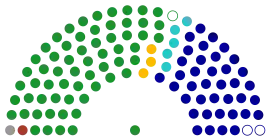 | |
Political groups | Government (63)
Supported by (2)
Opposition (48)
|
Length of term | 4 years |
| Elections | |
Parallel voting:
| |
Last election | 11 January 2020 |
Next election | On or before 2024 |
| Meeting place | |
_Legislative_Yuan_of_the_Republic_of_China_(chamber%252C_exterior).jpg.webp) | |
| The Legislative Yuan Building, No. 1, Zhongshan South Road Zhongzheng District, Taipei, Republic of China | |
| Website | |
| www.ly.gov.tw (in English) | |
| Constitution | |
| Additional Articles and the original Constitution of the Republic of China | |
| Legislative Yuan | |||||||||||||||||||||||||||
|---|---|---|---|---|---|---|---|---|---|---|---|---|---|---|---|---|---|---|---|---|---|---|---|---|---|---|---|
| Chinese | 立法院 | ||||||||||||||||||||||||||
| Literal meaning | Law-establishing court | ||||||||||||||||||||||||||
| |||||||||||||||||||||||||||
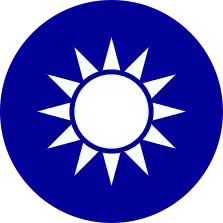 |
|---|
| This article is part of a series on the politics and government of the Republic of China |
|
|
Under the current amended Constitution and in accordance with the separation of powers, the Legislative Yuan, as the only parliamentary body, also holds the power to initiate several constitutional processes, including initiating constitutional amendments (then determined by a national referendum), recalls of the President (then determined by a recall vote), and impeachments of the President (then judged by the Constitutional Court).
Composition
Legislators
Starting with the 2008 legislative elections, changes were made to the Legislative Yuan in accordance with a constitutional amendment passed in 2005. The Legislative Yuan has 113 members serving four-year terms. The current Legislative Yuan was inaugurated on February 1, 2020 and its term expires on January 31, 2024.
| Party/Caucus | Caucus leader | Seats | |
|---|---|---|---|
| Democratic Progressive Party (DPP) Caucus | Ker Chien-ming (majority) | 63 | |
| Kuomintang (KMT) Caucus | Alex Fai (minority) | 40 | |
| Taiwan People's Party (TPP) | Lai Hsiang-lin (third-party) | 5 | |
| New Power Party (NPP) | Chiu Hsien-chih | 3 | |
| Cross-bench | None | 2 | |
| (as of 5 February 2020) | Total | 113 | |
The 5 largest parties with 3 seats or more can form caucuses. If there are fewer than 5 such parties, legislators in other parties or with no party affiliation can form caucuses with at least 4 members.[3]
Leadership
The President and Vice President of the Legislative Yuan are elected by the 113 legislators during a preparatory session in the beginning of their 4-year terms. President and Vice President of the Legislative Yuan sometimes translate to speaker and deputy speaker respectively in English.[4]
Functions
Powers
Like parliaments or congresses of other countries, the Legislative Yuan holds the following power according to the current amended Constitution[5]
- make laws and approve national budget, treaties, and emergency decrees issued by the President
- review executive decrees
- interpellation of government officials
- initiate no-confidence vote against the Executive Yuan
- approve appointments to the Examination Yuan, the Control Yuan, the Grand Justices, the Auditor General, the Public Prosecutor General, the National Communications Commission, the Fair Trade Commission and the Central Election Commission,
- initiate the recall of the President or the Vice President, and the impeachment of the President or the Vice President
- initiate constitutional amendments, which must be referred to a referendum
Other governmental organs are authorized to propose legislative bills to the Legislative Yuan. Legislative bills proposed to the Legislative Yuan have to be cosigned by a certain number of legislators. Once a bill reaches the legislature, it is subject to a process of three readings.
Committees
- Standing Committees
- Internal Administration Committee
- Social Welfare and Environmental Hygiene Committee
- Judiciary and Organic Laws and Statutes Committee
- Transportation Committee
- Education and Culture Committee
- Finance Committee
- Economics Committee
- Foreign and National Defense Committee
- Ad Hoc Committees
- Procedure Committee
- Expenditure Examination Committee
- Constitutional Amendment Committee
- Discipline Committee
History
Constitutional theory
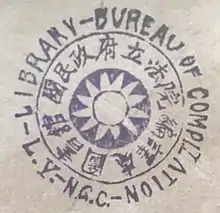
The concept of Legislative Yuan was introduced by Sun Yat-sen's Three Principles of the People. The theory proposed a separation of powers into five branches (五院; wǔyuàn; gō͘-īⁿ). The Legislative Yuan, under Sun's political theory, is a branch of government elected by the National Assembly that serves as the standing legislative body when the National Assembly is not in session.
The 1947 Constitution of the Republic of China has many influence from the resolutions of the Political Consultative Assembly held between the Chinese Nationalist Party (Kuomintang) and the Chinese Communist Party. The legislators are to be elected through direct elections. In the constitution, Legislative Yuan, together with National Assembly and Control Yuan, form three chambers of a tricameral parliament according to the Judicial Yuan's interpretation number 76 of the Constitution (1957).[6]
However, the later constitutional amendments in the 1990s removed the parliamentary roles from National Assembly and Control Yuan and transferred them to the Legislative Yuan, which became an unicameral parliament.
Establishment and relocation to Taiwan
_in_Nanjing%252C_Nov_2017.jpg.webp)
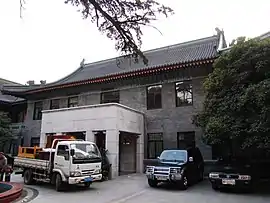
The original Legislative Yuan was formed in the original capital of Nanking after the completion of the Northern Expedition. Its 51 members were appointed to a term of two years. The 4th Legislative Yuan under this period had its members expanded to 194, and its term in office was extended to 14 years because of the Second Sino-Japanese War (1937–45). According to KMT political theory, these first four sessions marked the period of political tutelage.
The current Constitution of the Republic of China came into effect on 25 December 1947, and the first Legislative session convened in Nanking on 18 May 1948, with 760 members. Six preparatory meetings had been held on 8 May 1948, during which Sun Fo and Chen Li-fu were elected President and Vice President of the body. In 1949, the mainland fell to the Communist Party and the Legislative Yuan (along with the entire ROC government) was transplanted to Taipei. On 24 February 1950, 380 members convened at the Sun Yat-sen Hall in Taipei.
The first Legislative Yuan was to have been elected for a term of three years ending in 1951; however, the fall of mainland China made it impossible to hold new elections.[7] As a result, the Judicial Yuan decided that the members of the Legislative Yuan would continue to hold office until new elections could be held on the Mainland. This decision was made in the belief that the KMT would retake the Mainland in a short time. However, over the years, as the prospect of regaining the Mainland diminished, this meant that the legislators from mainland districts (and members of the ruling KMT) held their seats for life, in a one-party system. The body thus came to be called "the Non-reelected Congress".[7]
Over the years, deceased members elected on the mainland were not replaced while additional seats were created for Taiwan starting with eleven seats in 1969. Fifty-one new members were elected to a three-year term in 1972, fifty-two in 1975, ninety-seven in 1980, ninety-eight in 1983, one hundred in 1986, and one hundred thirty in 1989. Although the elected members of the Legislative Yuan did not have the majority to defeat legislation, they were able to use the Legislative Yuan as a platform to express political dissent. Opposition parties were formally illegal until 1991, but in the 1970s candidates to the Legislative Yuan would run as Tangwai ("outside the party"), and in 1985 candidates began to run under the banner of the Democratic Progressive Party.
Democratization
The members of the Legislative Yuan with extended terms remained until 31 December 1991, when as part of subsequent Judicial Yuan ruling they were forced to retire and the members elected in 1989 remained until the 161 members of the Second Legislative Yuan were elected in December 1992. The third LY, elected in 1995, had 157 members serving 3-year terms. The fourth LY, elected in 1998, was expanded to 225 members in part to include legislators from the abolished provincial legislature of Taiwan Province. The Legislative Yuan greatly increased its prominence after the 2000 Presidential elections in Taiwan when the Executive Yuan and presidency was controlled by the Democratic Progressive Party while the Legislative Yuan had a large majority of Kuomintang members. The legislative elections in late 2001 produced a contentious situation in which the pan-blue coalition has only a thin majority over the governing pan-green coalition in the legislature,[8] making the passage of bills often dependent on the votes of a few defectors and independents. Because of the party situation there have been constitutional conflicts between the Legislative Yuan and the executive branch over the process of appointment for the premier and whether the president has the power to call a special session.
Amid 70% public support, the Legislative Yuan voted 217–1 on 23 August 2004 for a package of amendments to:
- Halve the number of seats from 225 to 113
- Switch to a single-member district parallel voting electoral system
- Increase the terms of members from 3 to 4 years, to synchronize the legislative and presidential elections. (The change was implemented for the next election cycle, as the legislative election was held in January 2008, and the presidential election followed in March.)
The new electoral system installed in 2008 includes 73 plurality seats (one for each electoral district), 6 seats for aboriginals, with the remaining 34 seats to be filled from party lists. Every county has a minimum of 1 electoral district, thereby guaranteed at least one seat in the legislature, while half of the proportionally represented seats drawn from party lists must be women.
Additionally, the Legislative Yuan proposed to abolish the National Assembly. Future amendments would still be proposed by the LY by a three-fourths vote from a quorum of at least three-fourths of all members of the Legislature. After a mandatory 180-day promulgation period, the amendment would have to be ratified by an absolute majority of all eligible voters of the ROC irrespective of voter turnout. The latter requirement would allow a party to kill a referendum proposal by asking that their voters boycott the vote as was done by the KMT with the referendums associated with the 2004 Presidential Election.
A DPP proposal to allow the citizens the right to initiate constitutional referendums was pulled off the table, due to a lack of support. The proposal was criticized for dangerously lowering the threshold for considering a constitutional amendment. Whereas a three-fourths vote of the LY would require that any proposed constitutional amendment have a broad political consensus behind it, a citizen's initiative would allow a fraction of the electorate to force a constitutional referendum. It was feared that allowing this to occur would result in a referendum on Taiwan independence which would likely result in a crisis with the People's Republic of China.
The Legislative Yuan also proposed to give itself the power to summon the president for an annual "state of the nation" address and launch a recall of the president and vice president (proposed by one fourth and approved by two thirds of the legislators and be submitted to a nationwide referendum for approval or rejection by majority vote). The Legislative Yuan will also have the power to propose the impeachment of the president or vice president to the Council of Grand Justices.
An ad hoc National Assembly was elected and formed in 2005 to ratify the amendments. The downsized Legislative Yuan took effect after the 2008 elections.
On 20 July 2007, the Legislative Yuan passed a Lobbying Act.[9]
Elections and terms
The Kuomintang-led government of the Republic of China retreated to Taiwan in 1949, the year following the first legislative elections (1948) after the enactment of the 1947 constitution. As the Kuomintang government continues to claim sovereignty over Mainland China, the term of the original legislators was extended until "re-election is possible in their original electoral districts." In response to the increasing democracy movement in Taiwan, limited supplementary elections were held in Taiwan starting from 1969 and parts of Fujian from 1972. Legislators elected in these supplementary elections served together with those who were elected in 1948. This situation remained until a Constitutional Court (Judicial Yuan) ruling on June 21, 1991 that ordered the retirement of all members with extended terms by the end of 1991.[10]
| Term | Length | Actual served | Election | Seats | Note |
|---|---|---|---|---|---|
| 1st | Initially 3 years, then limit removed by Temporary Provisions | May 8, 1948–Jan 31, 1993 (See Note column for detailed terms) |
1948 election | 759 | The only election held in mainland China. 8 seats were elected in Taiwan. 509 members retreated to Taiwan with the government; served until the end of 1991. |
| 1969 supp | 11 | Elected in Taiwan; terms equal to the 1948-elected members | |||
| 1972 1st supp | 51 | Elected in the Free Area with 3-year terms. | |||
| 1975 2nd supp | 52 | Elected in the Free Area with 3-year terms; then extended to 5 years. | |||
| 1980 3rd supp | 97 | Elected in the Free Area with 3-year terms. | |||
| 1983 4th supp | 98 | Elected in the Free Area with 3-year terms. | |||
| 1986 5th supp | 100 | Elected in the Free Area with 3-year terms. | |||
| 1989 6th supp | 130 | Elected in the Free Area with 3-year terms; served until Jan 31, 1993. | |||
| 2nd | 3 years | Feb 1, 1993—Jan 31, 1996 | 1992 election | 161 | Total re-election in the Free Area |
| 3rd | Feb 1, 1996—Jan 31, 1999 | 1995 election | 164 | ||
| 4th | Feb 1, 1999—Jan 31, 2002 | 1998 election | 225 | ||
| 5th | Feb 1, 2002—Jan 31, 2005 | 2001 election | |||
| 6th | Feb 1, 2005—Jan 31, 2008 | 2004 election | |||
| 7th | 4 years | Feb 1, 2008—Jan 31, 2012 | 2008 election | 113 | Introduced changes in the electoral system, term length, and seat numbers. |
| 8th | Feb 1, 2012—Jan 31, 2016 | 2012 election | |||
| 9th | Feb 1, 2016—Jan 31, 2020 | 2016 election | |||
| 10th | Feb 1, 2020—Jan 31, 2024 | 2020 election | Incumbent |
Timeline of Legislative Yuan elections and terms
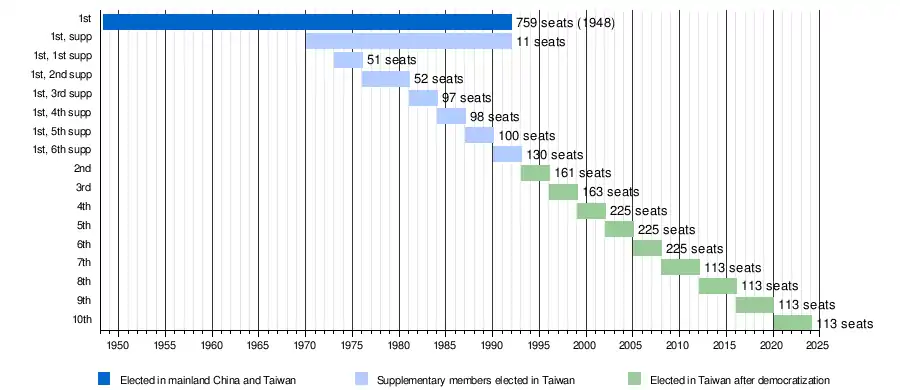
The legislature had 225 members during the 4th, 5th, and 6th terms. Legislators were elected as follows:
- 168 were elected by popular vote through single non-transferable vote in multi-member consistencies.
- 41 were elected on the basis of the proportion of nationwide votes received by participating political parties.
- 8 were allocated for overseas citizens and were selected by the parties on the basis of the proportion of votes received nationwide.
- 8 seats were reserved for the indigenous populations.
Since the 7th term, the 113 legislators are elected to office as follows:
- 73 are elected under the first-past-the-post system in single-member constituencies.
- 34 are elected under the supplementary member system on a second ballot, based on nationwide votes, and calculated using the largest remainder method by the Hare quota.[11] Any party which receives 5% or more of the party vote can enter the parliament. For each party, at least half of the legislators elected under this system must be female.
- 6 seats are elected by indigenous voters through single non-transferable vote in two three-member constituencies.
Composition by term
The Kuomintang (KMT) held a supermajority of seats in the Legislative Yuan between 1948 and 1991, while some seats were held by the Chinese Youth Party (CYP) and the China Democratic Socialist Party (CDSP). Through the limited supplementary elections held in since the 1970s, the Tangwai movement saw their share of seats increase. Most members in the Tangwai movement joined the Democratic Progressive Party (DPP) after its founding in the late 1980s.
majority plurality only largest minority
Issues
Protests and occupation
On 18 March 2014, the Legislative Yuan was occupied by protesting students.[12]
Legislative violence
Much of the work of the Legislative Yuan is done via legislative committees, and a common sight on Taiwanese television involves officials of the executive branch answering extremely hostile questions from opposition members in committees. In the 1990s, there were a number of cases of violence breaking out on the floor, usually triggered by some perceived unfair procedure ruling, but in recent years, these have become less common. There was a brawl involving 50 legislators in January 2007 and an incident involving 40 legislators on 8 May 2007 when a speaker attempted to speak about reconfiguring the Central Election Committee. It has been alleged that fights are staged and planned in advance.[13] These antics led the scientific humor magazine Annals of Improbable Research to award the Legislative Yuan its Ig Nobel Peace Prize in 1995 "for demonstrating that politicians gain more by punching, kicking and gouging each other than by waging war against other nations".[14] On the 29 June 2020 more than 20 lawmaker from the opposition party Kuomintang took over the legislature over night. Blocking entry to the main chamber with chains and chairs, saying the government was trying to force through legislation and demanding the president withdraw the nomination of a close aide to a high-level watchdog. DPP lawmakers forced themselves in while there where scuffles and shouting with Kuomintang lawmakers.
Gallery
_Legislative_Yuan_of_the_Republic_of_China_(chamber%252C_interior).jpg.webp) The chamber of the Legislative Yuan.
The chamber of the Legislative Yuan..JPG.webp) Legislative Yuan building.
Legislative Yuan building.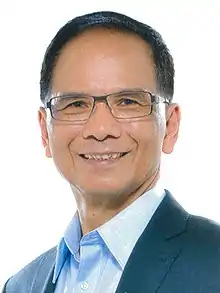 Yu Shyi-kun, the current President of the Legislative Yuan.
Yu Shyi-kun, the current President of the Legislative Yuan..jpg.webp) Wang Jin-pyng, the longest-serving President of the Legislative Yuan.
Wang Jin-pyng, the longest-serving President of the Legislative Yuan.
See also
Notes
- Beginning of term
- Due to by-elections
- Due to changes in member affiliation
- One member lost due to criminal charge
References
- "Concise History". Legislative Yuan. Retrieved 3 July 2017.
- 立法院全球資訊網-認識立法院-簡史. www.ly.gov.tw (in Chinese). Retrieved 3 July 2017.
- "Legislative Yuan Organization Act". Article 33, Act of 14 November 2012 (in Chinese). Retrieved 12 January 2015.
- "DPP's Yu Shyi-kun elected legislative speaker". February 2, 2020.
- "About Legislative Yuan: Functions & Powers".
- 司法院釋字第76號解釋, Judicial Yuan interpretation number 76 (English translation)
- Joel Fetzer, J Christopher Soper, Confucianism, Democratization, and Human Rights in Taiwan, p 58, Lexington Books, 15 October 2012.
- Carr, Adam (2001). "Taiwan". Archived from the original on October 12, 2004.
- Shih Hsiu-chuan "Taiwan becomes third country to pass Lobbying Act", Taipei Times, 7/21/2007
- 中央選舉委員會歷次選舉摘要-立法委員選舉
- 公職人員選舉罷免法-全國法規資料庫入口網站. law.moj.gov.tw (in Chinese). Retrieved 27 August 2017.
- "TRADE PACT SIEGE: Legislative Yuan occupation timeline". Taipei Times. 11 April 2014. Retrieved 19 January 2015.
- "Parliamentary antics said to be staged", Taiwan News (newspaper), Vol. 58, No. 322, 18 May 2007, p. 2
- "The 1995 Ig Nobel Prize Winners". Winners of the Ig Nobel Prize. Annals of Improbable Research. Retrieved 2009-02-10.
External links
| Wikibooks has a book on the topic of: Annotated Republic of China Laws/Additional Articles of the Constitution of the Republic of China/Article 4 |
| Wikimedia Commons has media related to Legislative Yuan. |